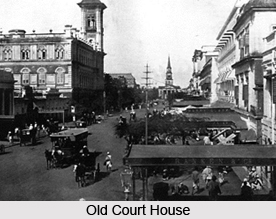 Esplanade is now the office and shopping hub in central Kolkata. This area is famous to the people of Kolkata for marketing. As this place has a proximity to Dalhousie, Esplanade serves as the office area for many government and private organisations.
Esplanade is now the office and shopping hub in central Kolkata. This area is famous to the people of Kolkata for marketing. As this place has a proximity to Dalhousie, Esplanade serves as the office area for many government and private organisations.
Location of Esplanade
Esplanade is a neighbourhood area of Government Place. This place is located in Central Kolkata, in the Indian state of West Bengal.
Esplanade in Old Days
Esplanade was the name given to the northern portion of jungle, which later formed The Maidan, also known as Brigade Parade Ground. In olden days, the modern Esplanade stretched from Dharmatola which is known as Lenin Sarani to Chandpal Ghat on the Hooghly River.
Foundation of Esplanade
Esplanade is known for the abode of walkers in British era. So the plan for esplanade came from the brain child of Warren Hastings- The Governor General of India after 1757. Esplanade was formed as a preferred public walk for aristocratic British people, who worked for British East India Company.
Esplanade and Fort William
 The strengthening of British power in Eastern India, subsequent to their victory in the Battle of Plassey by defeating Siraj ud daullah in 1757 was followed by the construction of the new Fort William, in 1758. The European inhabitants of Kalikata gradually forsook the narrow limits of the old palisades and moved to around the Maidan. After 1780, the jungle was converted into a place of walkers. There are a number of roads and streets which form part of or have been linked with the Esplanade for many years.
The strengthening of British power in Eastern India, subsequent to their victory in the Battle of Plassey by defeating Siraj ud daullah in 1757 was followed by the construction of the new Fort William, in 1758. The European inhabitants of Kalikata gradually forsook the narrow limits of the old palisades and moved to around the Maidan. After 1780, the jungle was converted into a place of walkers. There are a number of roads and streets which form part of or have been linked with the Esplanade for many years.
Street Food in Esplanade
The street food in Esplanade is synonymous to Dacares Lane. It is the short lane between Esplanade Row and Waterloo Street which was once a fashionable locality. It was named after Philip Milner Dacres, Collector of Kolkata in 1773 and afterwards a member of the Council. It has been renamed James Hicky Sarani in present era. This road is popularly referred to as the Tiffin Lane for busy people of Espanade.
Esplanade Row
Esplanade Row is running from Dharmatola right on to the banks of the river at Chandpal Ghat, passing on its way from Government House or Raj Bhavan and Council House, both facing south. Subsequently, it was divided by the gardens of Government House into two parts, Esplanade Row (East) and Esplanade Row (West). Esplanade Row (West) now runs between Government Place (West) and Strand Road, through the High Court. Esplanade Row (East) has been renamed Sidhu Kanu Dahar Street and occupies the northern end of the Maidan.
Tourism in Esplanade
Esplanade is the abode of foreign travellers and the photo walkers of Kolkata during winter. One can see the street food stalls and the street fashions throughout the year.
Old Court House Street which connects Esplanade Row (East) with B. B. D. Bagh, earlier known as Dalhousie Square is the point of photomeets in Kolkata, while the Council House Street connects the western part of B.B.D.Bagh with Esplanade Row and acquires its name from the old council house, which stood on the western portion of Government House. It was pulled down in 1800. Tipu Sultan Mosque is the prominent religious spot and the tourist location in Esplanade.



















